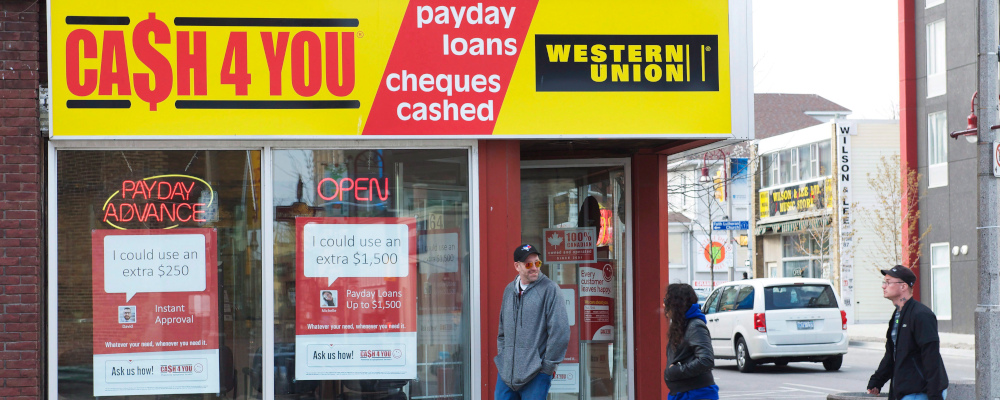The 2021 Liberal election platform—and the Prime Minister’s subsequent mandate letter to Finance Minister Chrystia Freeland—included a promise to “crack down on predatory lenders by lowering the criminal rate of interest.”
Presumably, any new legislation intended to fulfill this pledge would primarily target “alternative lenders”: finance companies that typically offer payday, title, or installment lending products. These loans cater mostly to those with low credit scores, little collateral, and short-term cash needs.
Payday loans are short-term. Lenders charge a fee of about $15 to $17 per $100 borrowed over a two-week period until the borrower’s next paycheque. These fees might seem innocuous. But calculated as an annual percentage rate (APR) of interest, these rates are very high (around 400 percent). Payday rates are exempt from the 60 percent legislated interest rate ceiling due to their low dollar value and short-term duration.
With installment and title loans, a borrower may take out a loan between a few hundred to $20,000 or more. Both loan types have terms ranging from a few months to five years. While the interest rates on these loans (around 20 to 50 percent) are lower than for payday loans, they are still very high. Given the greater principal borrowed and longer payment terms, the cash payments can be very burdensome.
It is easy to see why the government’s pledge to lower the maximum interest rate allowed is superficially attractive. After all, if unscrupulous Canadian businesses are gouging Canadian consumers, shouldn’t we welcome new laws that stop them from overcharging us? Some politicians and consumer advocates are calling for the 60 percent lending rate maximum to be lowered to between 20 to 30 percent.
The fact is, however, even with the very high rates charged, alternative lenders fill a market need. There are few other borrowing options for individuals with low or no credit scores.
Traditional banks and credit unions mostly limit personal lending and credit lines to borrowers with acceptable collateral and credit scores. In a federal government study of payday borrowers, only one in three surveyed said they had access to a credit card and only 10 percent had an available line of credit. Payday loan customers also point to better customer service and the ease, speed, and convenience of obtaining such a loan.
Related, but more troublesome, are reports that some payday loan customers are not comfortable in established financial institutions. In other words, they think their business is not wanted and feel subject to discrimination. Several credit unions have introduced lending products suited to non-secured, lower credit-rated customers, but the credit supply is nowhere near the size to replace the alternative lending sector.
Alternative lenders charge high rates because the loans they make are risky. Default rates are higher than those of traditional financial institutions. Physical storefronts add to a high fixed-cost business model. Lowering the interest rate ceiling as much as a few politicians and low-income advocates have called for, would make lending to lower credit-rated individuals uneconomical.
The same government study referenced above also reported that common reasons for needing a loan were for everyday expenses like car repairs, rent, or to avoid late payment charges on a bill. Less than one in 10 said it was to “buy something special.”
Based on these responses, access to short-term funds is essential to respondents’ financial wellbeing. They may need a car for employment. Unpaid bills could lead to late payment charges and even lower credit scores while missing a rent payment could mean eviction. Studies also report that “credit building loans,” a type of installment loan product, can help to improve credit scores for those with a poor credit rating. Restricting or eliminating alternative lenders will reduce credit access and increase the financial consequences for those who can no longer borrow.
This does not mean government cannot take steps to regulate credit markets to stamp out abuses. Several practical measures can be taken. The first lies in the type of information lenders receive when obtaining short-term, high-cost loans. Providing clear, easy-to-read loan information, in a manner that allows borrowers to think about and compare lending costs, leads to fewer loans used. Second, given that individuals with more financial knowledge use fewer high-cost loans, improving financial literacy is also important. Lastly, restricting the number of high-cost loans over a period reduces the chance a borrower falls into a debt trap. If we can meaningfully reduce high-cost loans usage without restricting credit access, we can avoid the negative unintended consequences that frequently occur when we use blunt market suppression tools.
It is understandable and appropriate that governments are concerned and looking to protect financially vulnerable Canadians. But lowering the maximum legal interest rate could backfire badly —and hurt those they are trying to help.
Recommended for You

Robert Asselin: How Canada can compete in a weaponized world economy

Why is your morning cup of coffee costing more? You can thank Trump’s tariffs

‘Raised expectations very high’: Five takeaways on the Liberals and Conservatives’ strategies for Parliament this fall

Trump tariffing low-cost goods will hurt Canadian consumers and businesses in new trade war attack: Experts



